University of South Australia COML 5009: Contract Law Assignment
VerifiedAdded on 2023/06/12
|11
|2468
|467
Homework Assignment
AI Summary
This assignment provides solutions to three distinct legal problems related to contract law. The first problem analyzes whether David can claim damages from a car park due to an exclusion clause, applying rules from cases like Olley V Marlborough Court and Thornton V Shoe Lane Parking to conclude the car park is liable. The second problem addresses whether Emily is entitled to claim remaining money from David, discussing part payment of debt and promissory estoppel, referencing Pinnel's Case and Foakes v Beer, ultimately concluding David must pay the full amount. The third problem examines whether Master Arts can rescind a contract with Laura for failing to provide agreed-upon sculptures, distinguishing between conditions and warranties, citing Poussard v Spiers and Bettini v Gye, to determine potential remedies. The document is available on Desklib, a platform offering a range of study resources for students.
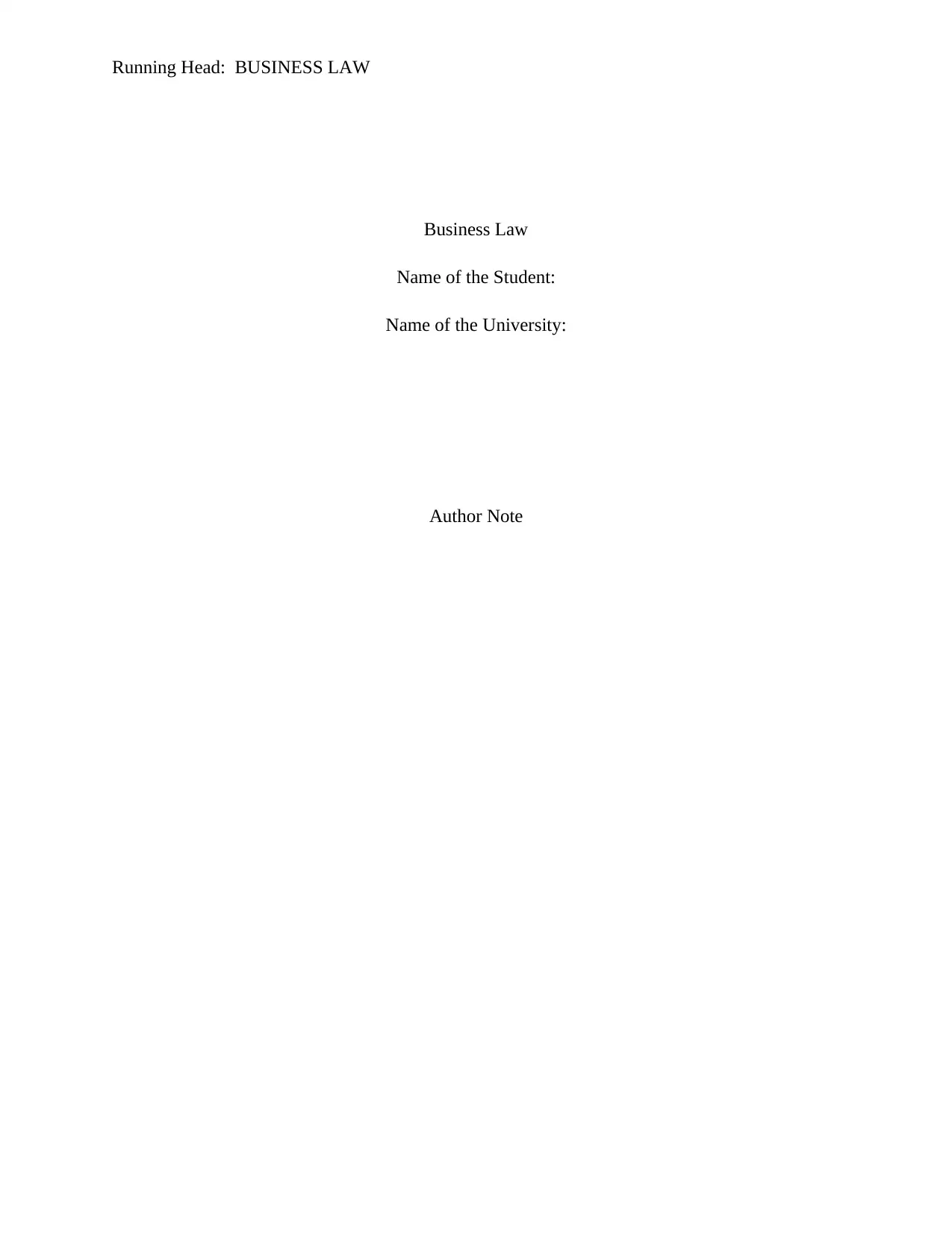
Running Head: BUSINESS LAW
Business Law
Name of the Student:
Name of the University:
Author Note
Business Law
Name of the Student:
Name of the University:
Author Note
Paraphrase This Document
Need a fresh take? Get an instant paraphrase of this document with our AI Paraphraser
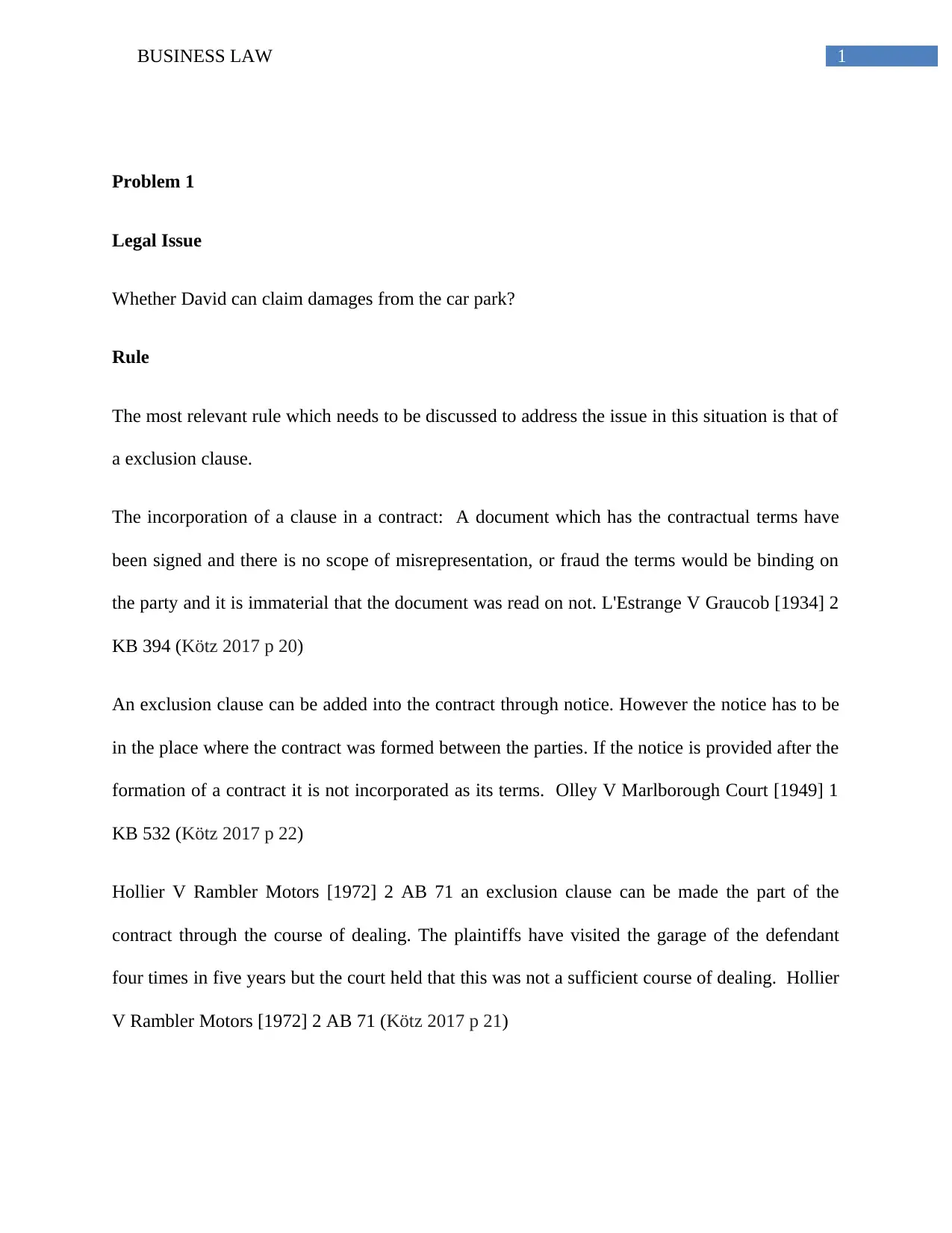
1BUSINESS LAW
Problem 1
Legal Issue
Whether David can claim damages from the car park?
Rule
The most relevant rule which needs to be discussed to address the issue in this situation is that of
a exclusion clause.
The incorporation of a clause in a contract: A document which has the contractual terms have
been signed and there is no scope of misrepresentation, or fraud the terms would be binding on
the party and it is immaterial that the document was read on not. L'Estrange V Graucob [1934] 2
KB 394 (Kötz 2017 p 20)
An exclusion clause can be added into the contract through notice. However the notice has to be
in the place where the contract was formed between the parties. If the notice is provided after the
formation of a contract it is not incorporated as its terms. Olley V Marlborough Court [1949] 1
KB 532 (Kötz 2017 p 22)
Hollier V Rambler Motors [1972] 2 AB 71 an exclusion clause can be made the part of the
contract through the course of dealing. The plaintiffs have visited the garage of the defendant
four times in five years but the court held that this was not a sufficient course of dealing. Hollier
V Rambler Motors [1972] 2 AB 71 (Kötz 2017 p 21)
Problem 1
Legal Issue
Whether David can claim damages from the car park?
Rule
The most relevant rule which needs to be discussed to address the issue in this situation is that of
a exclusion clause.
The incorporation of a clause in a contract: A document which has the contractual terms have
been signed and there is no scope of misrepresentation, or fraud the terms would be binding on
the party and it is immaterial that the document was read on not. L'Estrange V Graucob [1934] 2
KB 394 (Kötz 2017 p 20)
An exclusion clause can be added into the contract through notice. However the notice has to be
in the place where the contract was formed between the parties. If the notice is provided after the
formation of a contract it is not incorporated as its terms. Olley V Marlborough Court [1949] 1
KB 532 (Kötz 2017 p 22)
Hollier V Rambler Motors [1972] 2 AB 71 an exclusion clause can be made the part of the
contract through the course of dealing. The plaintiffs have visited the garage of the defendant
four times in five years but the court held that this was not a sufficient course of dealing. Hollier
V Rambler Motors [1972] 2 AB 71 (Kötz 2017 p 21)
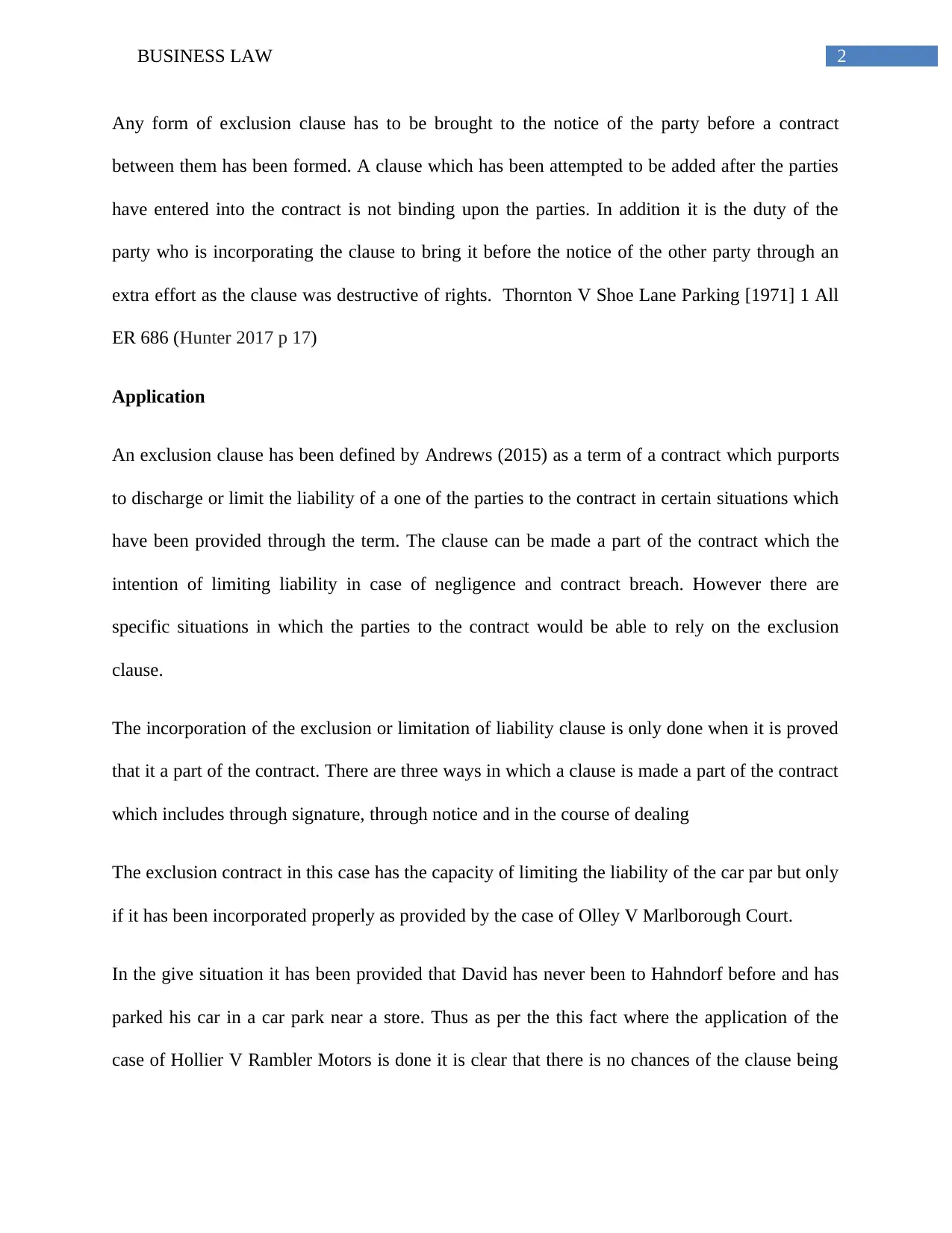
2BUSINESS LAW
Any form of exclusion clause has to be brought to the notice of the party before a contract
between them has been formed. A clause which has been attempted to be added after the parties
have entered into the contract is not binding upon the parties. In addition it is the duty of the
party who is incorporating the clause to bring it before the notice of the other party through an
extra effort as the clause was destructive of rights. Thornton V Shoe Lane Parking [1971] 1 All
ER 686 (Hunter 2017 p 17)
Application
An exclusion clause has been defined by Andrews (2015) as a term of a contract which purports
to discharge or limit the liability of a one of the parties to the contract in certain situations which
have been provided through the term. The clause can be made a part of the contract which the
intention of limiting liability in case of negligence and contract breach. However there are
specific situations in which the parties to the contract would be able to rely on the exclusion
clause.
The incorporation of the exclusion or limitation of liability clause is only done when it is proved
that it a part of the contract. There are three ways in which a clause is made a part of the contract
which includes through signature, through notice and in the course of dealing
The exclusion contract in this case has the capacity of limiting the liability of the car par but only
if it has been incorporated properly as provided by the case of Olley V Marlborough Court.
In the give situation it has been provided that David has never been to Hahndorf before and has
parked his car in a car park near a store. Thus as per the this fact where the application of the
case of Hollier V Rambler Motors is done it is clear that there is no chances of the clause being
Any form of exclusion clause has to be brought to the notice of the party before a contract
between them has been formed. A clause which has been attempted to be added after the parties
have entered into the contract is not binding upon the parties. In addition it is the duty of the
party who is incorporating the clause to bring it before the notice of the other party through an
extra effort as the clause was destructive of rights. Thornton V Shoe Lane Parking [1971] 1 All
ER 686 (Hunter 2017 p 17)
Application
An exclusion clause has been defined by Andrews (2015) as a term of a contract which purports
to discharge or limit the liability of a one of the parties to the contract in certain situations which
have been provided through the term. The clause can be made a part of the contract which the
intention of limiting liability in case of negligence and contract breach. However there are
specific situations in which the parties to the contract would be able to rely on the exclusion
clause.
The incorporation of the exclusion or limitation of liability clause is only done when it is proved
that it a part of the contract. There are three ways in which a clause is made a part of the contract
which includes through signature, through notice and in the course of dealing
The exclusion contract in this case has the capacity of limiting the liability of the car par but only
if it has been incorporated properly as provided by the case of Olley V Marlborough Court.
In the give situation it has been provided that David has never been to Hahndorf before and has
parked his car in a car park near a store. Thus as per the this fact where the application of the
case of Hollier V Rambler Motors is done it is clear that there is no chances of the clause being
⊘ This is a preview!⊘
Do you want full access?
Subscribe today to unlock all pages.

Trusted by 1+ million students worldwide
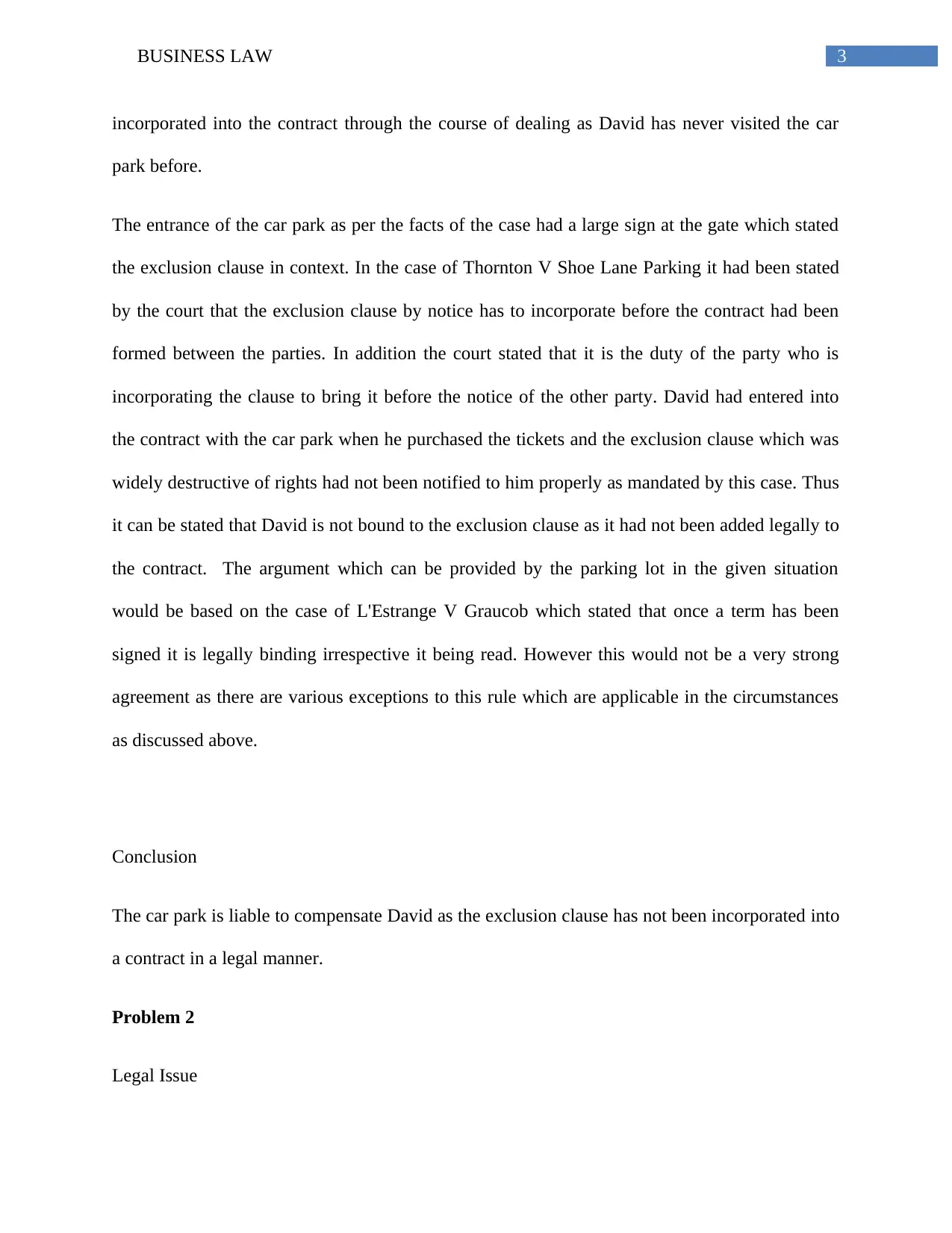
3BUSINESS LAW
incorporated into the contract through the course of dealing as David has never visited the car
park before.
The entrance of the car park as per the facts of the case had a large sign at the gate which stated
the exclusion clause in context. In the case of Thornton V Shoe Lane Parking it had been stated
by the court that the exclusion clause by notice has to incorporate before the contract had been
formed between the parties. In addition the court stated that it is the duty of the party who is
incorporating the clause to bring it before the notice of the other party. David had entered into
the contract with the car park when he purchased the tickets and the exclusion clause which was
widely destructive of rights had not been notified to him properly as mandated by this case. Thus
it can be stated that David is not bound to the exclusion clause as it had not been added legally to
the contract. The argument which can be provided by the parking lot in the given situation
would be based on the case of L'Estrange V Graucob which stated that once a term has been
signed it is legally binding irrespective it being read. However this would not be a very strong
agreement as there are various exceptions to this rule which are applicable in the circumstances
as discussed above.
Conclusion
The car park is liable to compensate David as the exclusion clause has not been incorporated into
a contract in a legal manner.
Problem 2
Legal Issue
incorporated into the contract through the course of dealing as David has never visited the car
park before.
The entrance of the car park as per the facts of the case had a large sign at the gate which stated
the exclusion clause in context. In the case of Thornton V Shoe Lane Parking it had been stated
by the court that the exclusion clause by notice has to incorporate before the contract had been
formed between the parties. In addition the court stated that it is the duty of the party who is
incorporating the clause to bring it before the notice of the other party. David had entered into
the contract with the car park when he purchased the tickets and the exclusion clause which was
widely destructive of rights had not been notified to him properly as mandated by this case. Thus
it can be stated that David is not bound to the exclusion clause as it had not been added legally to
the contract. The argument which can be provided by the parking lot in the given situation
would be based on the case of L'Estrange V Graucob which stated that once a term has been
signed it is legally binding irrespective it being read. However this would not be a very strong
agreement as there are various exceptions to this rule which are applicable in the circumstances
as discussed above.
Conclusion
The car park is liable to compensate David as the exclusion clause has not been incorporated into
a contract in a legal manner.
Problem 2
Legal Issue
Paraphrase This Document
Need a fresh take? Get an instant paraphrase of this document with our AI Paraphraser
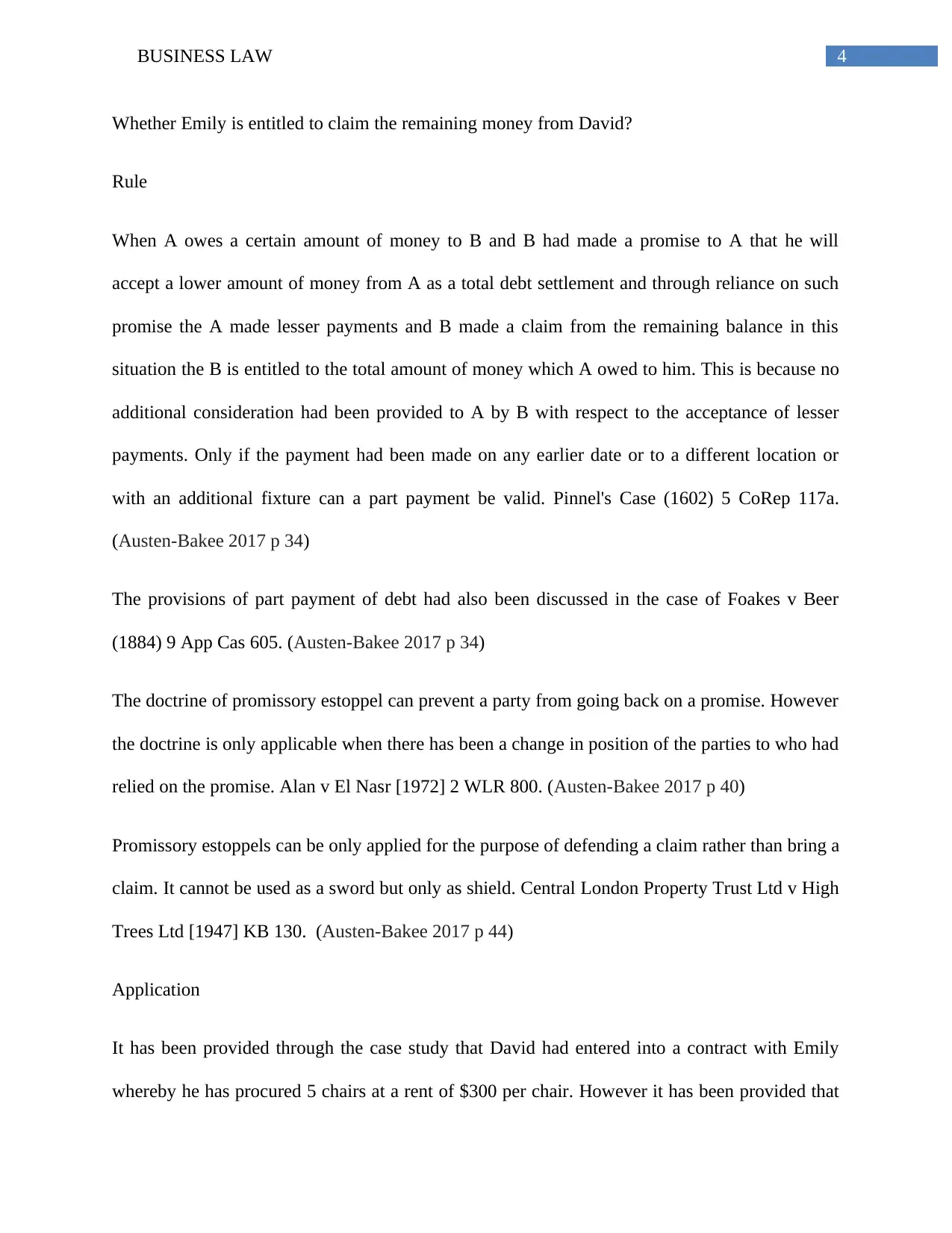
4BUSINESS LAW
Whether Emily is entitled to claim the remaining money from David?
Rule
When A owes a certain amount of money to B and B had made a promise to A that he will
accept a lower amount of money from A as a total debt settlement and through reliance on such
promise the A made lesser payments and B made a claim from the remaining balance in this
situation the B is entitled to the total amount of money which A owed to him. This is because no
additional consideration had been provided to A by B with respect to the acceptance of lesser
payments. Only if the payment had been made on any earlier date or to a different location or
with an additional fixture can a part payment be valid. Pinnel's Case (1602) 5 CoRep 117a.
(Austen-Bakee 2017 p 34)
The provisions of part payment of debt had also been discussed in the case of Foakes v Beer
(1884) 9 App Cas 605. (Austen-Bakee 2017 p 34)
The doctrine of promissory estoppel can prevent a party from going back on a promise. However
the doctrine is only applicable when there has been a change in position of the parties to who had
relied on the promise. Alan v El Nasr [1972] 2 WLR 800. (Austen-Bakee 2017 p 40)
Promissory estoppels can be only applied for the purpose of defending a claim rather than bring a
claim. It cannot be used as a sword but only as shield. Central London Property Trust Ltd v High
Trees Ltd [1947] KB 130. (Austen-Bakee 2017 p 44)
Application
It has been provided through the case study that David had entered into a contract with Emily
whereby he has procured 5 chairs at a rent of $300 per chair. However it has been provided that
Whether Emily is entitled to claim the remaining money from David?
Rule
When A owes a certain amount of money to B and B had made a promise to A that he will
accept a lower amount of money from A as a total debt settlement and through reliance on such
promise the A made lesser payments and B made a claim from the remaining balance in this
situation the B is entitled to the total amount of money which A owed to him. This is because no
additional consideration had been provided to A by B with respect to the acceptance of lesser
payments. Only if the payment had been made on any earlier date or to a different location or
with an additional fixture can a part payment be valid. Pinnel's Case (1602) 5 CoRep 117a.
(Austen-Bakee 2017 p 34)
The provisions of part payment of debt had also been discussed in the case of Foakes v Beer
(1884) 9 App Cas 605. (Austen-Bakee 2017 p 34)
The doctrine of promissory estoppel can prevent a party from going back on a promise. However
the doctrine is only applicable when there has been a change in position of the parties to who had
relied on the promise. Alan v El Nasr [1972] 2 WLR 800. (Austen-Bakee 2017 p 40)
Promissory estoppels can be only applied for the purpose of defending a claim rather than bring a
claim. It cannot be used as a sword but only as shield. Central London Property Trust Ltd v High
Trees Ltd [1947] KB 130. (Austen-Bakee 2017 p 44)
Application
It has been provided through the case study that David had entered into a contract with Emily
whereby he has procured 5 chairs at a rent of $300 per chair. However it has been provided that
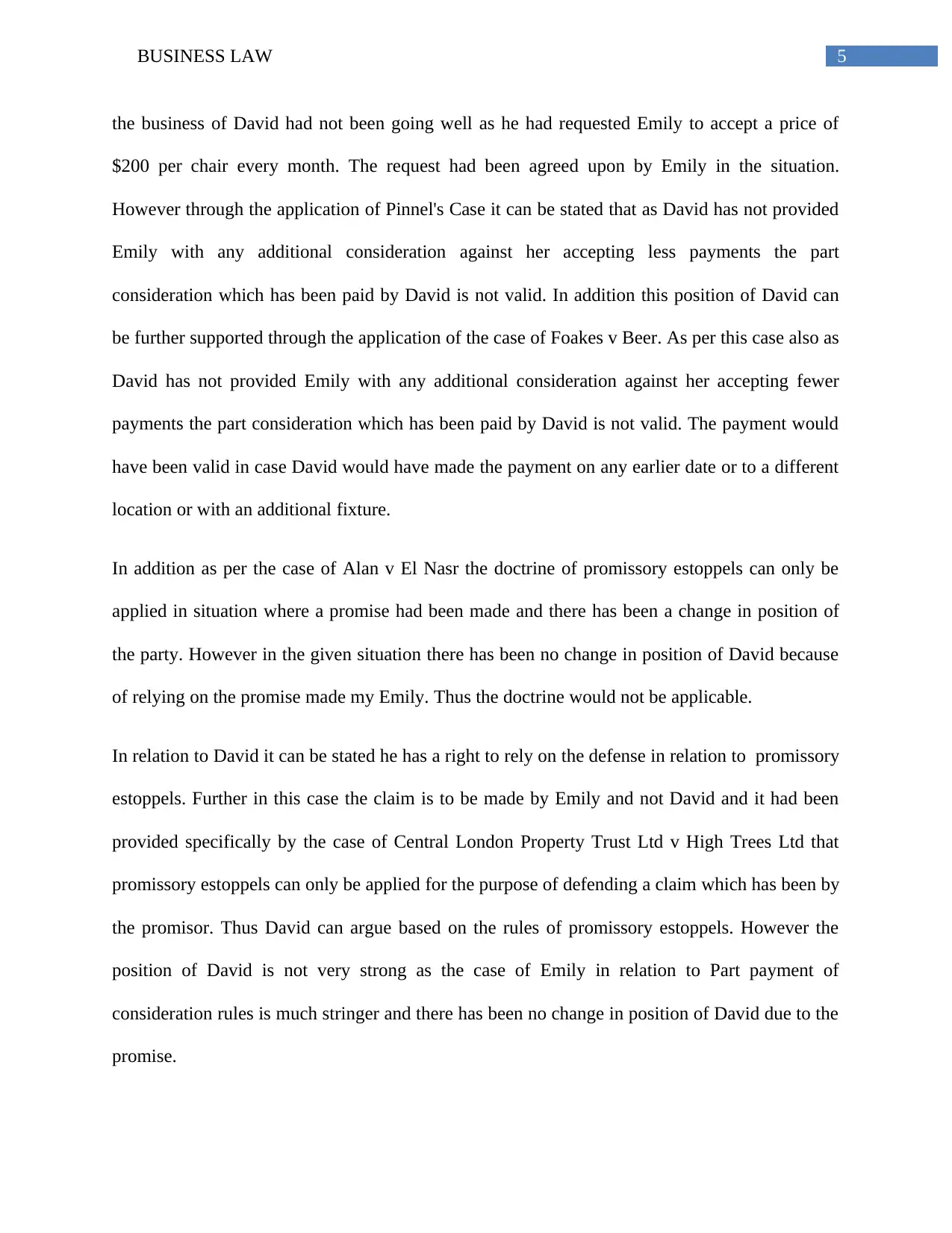
5BUSINESS LAW
the business of David had not been going well as he had requested Emily to accept a price of
$200 per chair every month. The request had been agreed upon by Emily in the situation.
However through the application of Pinnel's Case it can be stated that as David has not provided
Emily with any additional consideration against her accepting less payments the part
consideration which has been paid by David is not valid. In addition this position of David can
be further supported through the application of the case of Foakes v Beer. As per this case also as
David has not provided Emily with any additional consideration against her accepting fewer
payments the part consideration which has been paid by David is not valid. The payment would
have been valid in case David would have made the payment on any earlier date or to a different
location or with an additional fixture.
In addition as per the case of Alan v El Nasr the doctrine of promissory estoppels can only be
applied in situation where a promise had been made and there has been a change in position of
the party. However in the given situation there has been no change in position of David because
of relying on the promise made my Emily. Thus the doctrine would not be applicable.
In relation to David it can be stated he has a right to rely on the defense in relation to promissory
estoppels. Further in this case the claim is to be made by Emily and not David and it had been
provided specifically by the case of Central London Property Trust Ltd v High Trees Ltd that
promissory estoppels can only be applied for the purpose of defending a claim which has been by
the promisor. Thus David can argue based on the rules of promissory estoppels. However the
position of David is not very strong as the case of Emily in relation to Part payment of
consideration rules is much stringer and there has been no change in position of David due to the
promise.
the business of David had not been going well as he had requested Emily to accept a price of
$200 per chair every month. The request had been agreed upon by Emily in the situation.
However through the application of Pinnel's Case it can be stated that as David has not provided
Emily with any additional consideration against her accepting less payments the part
consideration which has been paid by David is not valid. In addition this position of David can
be further supported through the application of the case of Foakes v Beer. As per this case also as
David has not provided Emily with any additional consideration against her accepting fewer
payments the part consideration which has been paid by David is not valid. The payment would
have been valid in case David would have made the payment on any earlier date or to a different
location or with an additional fixture.
In addition as per the case of Alan v El Nasr the doctrine of promissory estoppels can only be
applied in situation where a promise had been made and there has been a change in position of
the party. However in the given situation there has been no change in position of David because
of relying on the promise made my Emily. Thus the doctrine would not be applicable.
In relation to David it can be stated he has a right to rely on the defense in relation to promissory
estoppels. Further in this case the claim is to be made by Emily and not David and it had been
provided specifically by the case of Central London Property Trust Ltd v High Trees Ltd that
promissory estoppels can only be applied for the purpose of defending a claim which has been by
the promisor. Thus David can argue based on the rules of promissory estoppels. However the
position of David is not very strong as the case of Emily in relation to Part payment of
consideration rules is much stringer and there has been no change in position of David due to the
promise.
⊘ This is a preview!⊘
Do you want full access?
Subscribe today to unlock all pages.

Trusted by 1+ million students worldwide
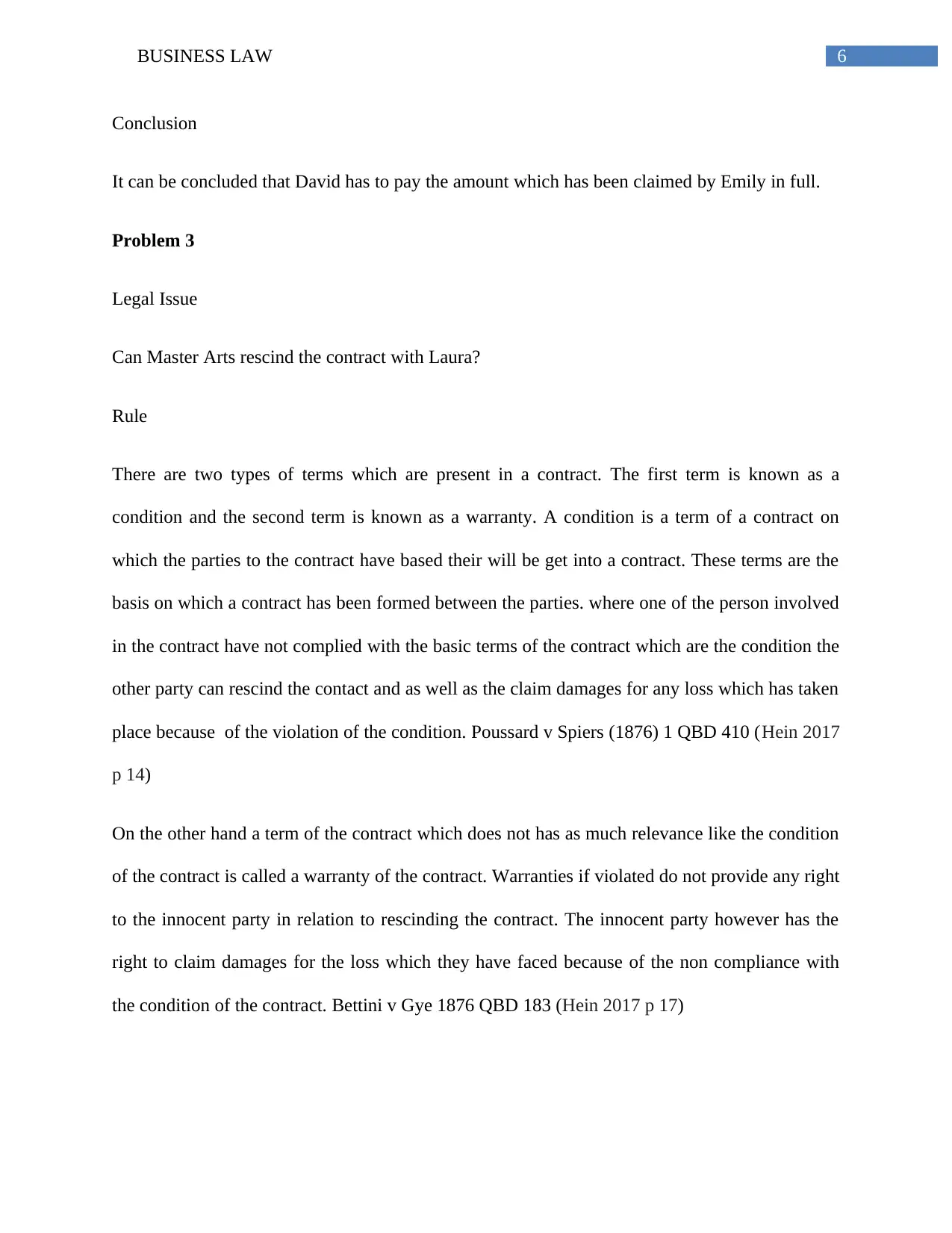
6BUSINESS LAW
Conclusion
It can be concluded that David has to pay the amount which has been claimed by Emily in full.
Problem 3
Legal Issue
Can Master Arts rescind the contract with Laura?
Rule
There are two types of terms which are present in a contract. The first term is known as a
condition and the second term is known as a warranty. A condition is a term of a contract on
which the parties to the contract have based their will be get into a contract. These terms are the
basis on which a contract has been formed between the parties. where one of the person involved
in the contract have not complied with the basic terms of the contract which are the condition the
other party can rescind the contact and as well as the claim damages for any loss which has taken
place because of the violation of the condition. Poussard v Spiers (1876) 1 QBD 410 (Hein 2017
p 14)
On the other hand a term of the contract which does not has as much relevance like the condition
of the contract is called a warranty of the contract. Warranties if violated do not provide any right
to the innocent party in relation to rescinding the contract. The innocent party however has the
right to claim damages for the loss which they have faced because of the non compliance with
the condition of the contract. Bettini v Gye 1876 QBD 183 (Hein 2017 p 17)
Conclusion
It can be concluded that David has to pay the amount which has been claimed by Emily in full.
Problem 3
Legal Issue
Can Master Arts rescind the contract with Laura?
Rule
There are two types of terms which are present in a contract. The first term is known as a
condition and the second term is known as a warranty. A condition is a term of a contract on
which the parties to the contract have based their will be get into a contract. These terms are the
basis on which a contract has been formed between the parties. where one of the person involved
in the contract have not complied with the basic terms of the contract which are the condition the
other party can rescind the contact and as well as the claim damages for any loss which has taken
place because of the violation of the condition. Poussard v Spiers (1876) 1 QBD 410 (Hein 2017
p 14)
On the other hand a term of the contract which does not has as much relevance like the condition
of the contract is called a warranty of the contract. Warranties if violated do not provide any right
to the innocent party in relation to rescinding the contract. The innocent party however has the
right to claim damages for the loss which they have faced because of the non compliance with
the condition of the contract. Bettini v Gye 1876 QBD 183 (Hein 2017 p 17)
Paraphrase This Document
Need a fresh take? Get an instant paraphrase of this document with our AI Paraphraser
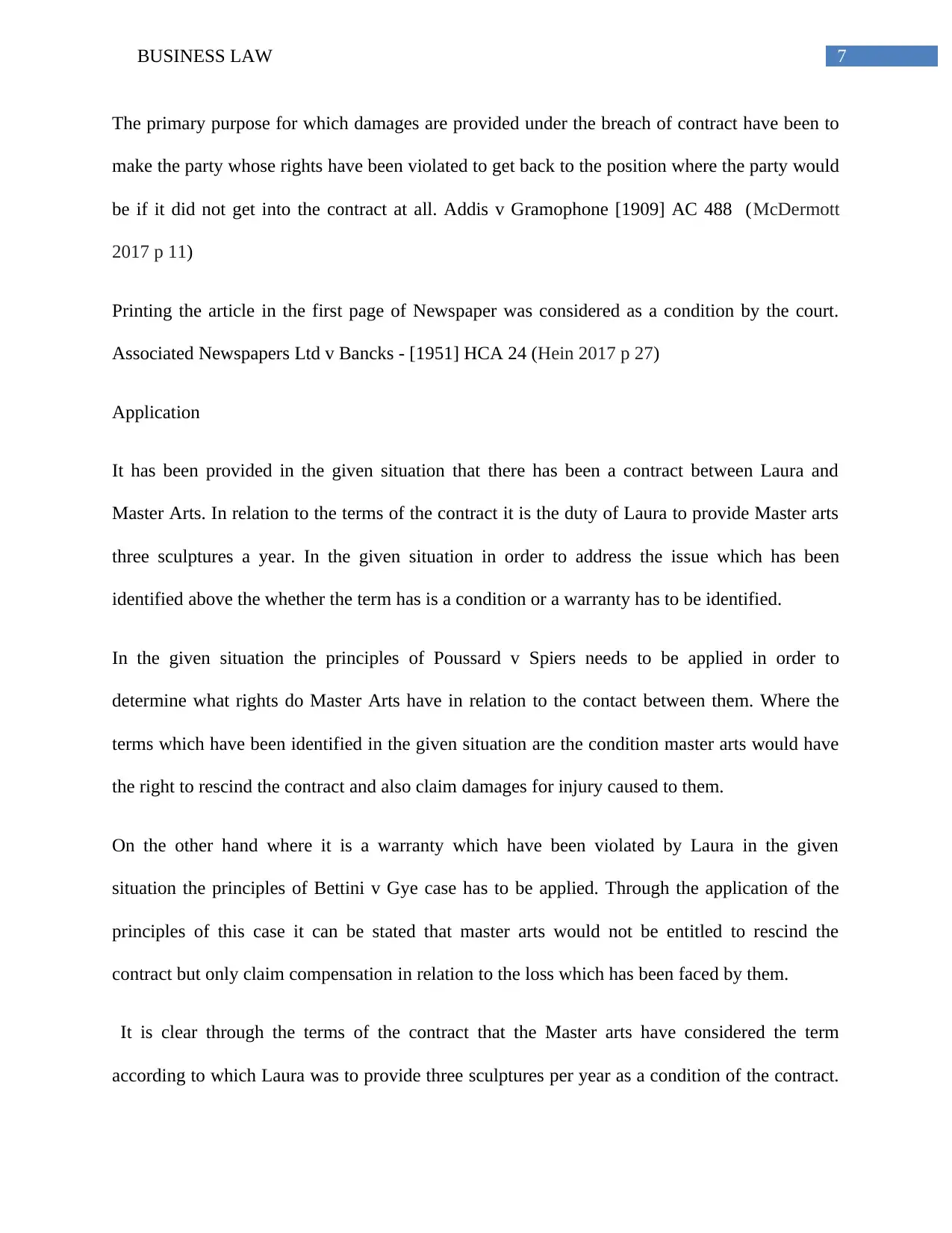
7BUSINESS LAW
The primary purpose for which damages are provided under the breach of contract have been to
make the party whose rights have been violated to get back to the position where the party would
be if it did not get into the contract at all. Addis v Gramophone [1909] AC 488 (McDermott
2017 p 11)
Printing the article in the first page of Newspaper was considered as a condition by the court.
Associated Newspapers Ltd v Bancks - [1951] HCA 24 (Hein 2017 p 27)
Application
It has been provided in the given situation that there has been a contract between Laura and
Master Arts. In relation to the terms of the contract it is the duty of Laura to provide Master arts
three sculptures a year. In the given situation in order to address the issue which has been
identified above the whether the term has is a condition or a warranty has to be identified.
In the given situation the principles of Poussard v Spiers needs to be applied in order to
determine what rights do Master Arts have in relation to the contact between them. Where the
terms which have been identified in the given situation are the condition master arts would have
the right to rescind the contract and also claim damages for injury caused to them.
On the other hand where it is a warranty which have been violated by Laura in the given
situation the principles of Bettini v Gye case has to be applied. Through the application of the
principles of this case it can be stated that master arts would not be entitled to rescind the
contract but only claim compensation in relation to the loss which has been faced by them.
It is clear through the terms of the contract that the Master arts have considered the term
according to which Laura was to provide three sculptures per year as a condition of the contract.
The primary purpose for which damages are provided under the breach of contract have been to
make the party whose rights have been violated to get back to the position where the party would
be if it did not get into the contract at all. Addis v Gramophone [1909] AC 488 (McDermott
2017 p 11)
Printing the article in the first page of Newspaper was considered as a condition by the court.
Associated Newspapers Ltd v Bancks - [1951] HCA 24 (Hein 2017 p 27)
Application
It has been provided in the given situation that there has been a contract between Laura and
Master Arts. In relation to the terms of the contract it is the duty of Laura to provide Master arts
three sculptures a year. In the given situation in order to address the issue which has been
identified above the whether the term has is a condition or a warranty has to be identified.
In the given situation the principles of Poussard v Spiers needs to be applied in order to
determine what rights do Master Arts have in relation to the contact between them. Where the
terms which have been identified in the given situation are the condition master arts would have
the right to rescind the contract and also claim damages for injury caused to them.
On the other hand where it is a warranty which have been violated by Laura in the given
situation the principles of Bettini v Gye case has to be applied. Through the application of the
principles of this case it can be stated that master arts would not be entitled to rescind the
contract but only claim compensation in relation to the loss which has been faced by them.
It is clear through the terms of the contract that the Master arts have considered the term
according to which Laura was to provide three sculptures per year as a condition of the contract.
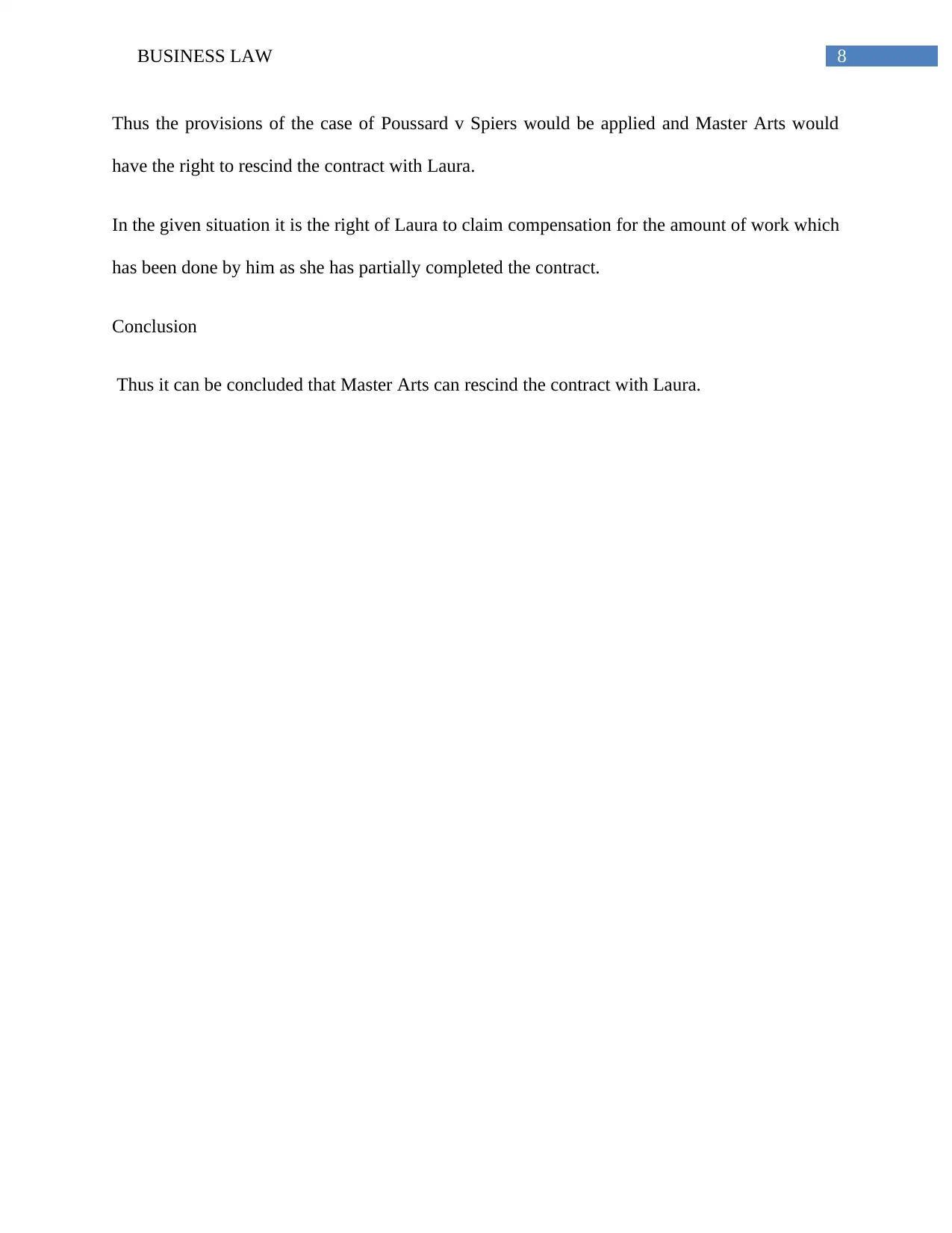
8BUSINESS LAW
Thus the provisions of the case of Poussard v Spiers would be applied and Master Arts would
have the right to rescind the contract with Laura.
In the given situation it is the right of Laura to claim compensation for the amount of work which
has been done by him as she has partially completed the contract.
Conclusion
Thus it can be concluded that Master Arts can rescind the contract with Laura.
Thus the provisions of the case of Poussard v Spiers would be applied and Master Arts would
have the right to rescind the contract with Laura.
In the given situation it is the right of Laura to claim compensation for the amount of work which
has been done by him as she has partially completed the contract.
Conclusion
Thus it can be concluded that Master Arts can rescind the contract with Laura.
⊘ This is a preview!⊘
Do you want full access?
Subscribe today to unlock all pages.

Trusted by 1+ million students worldwide
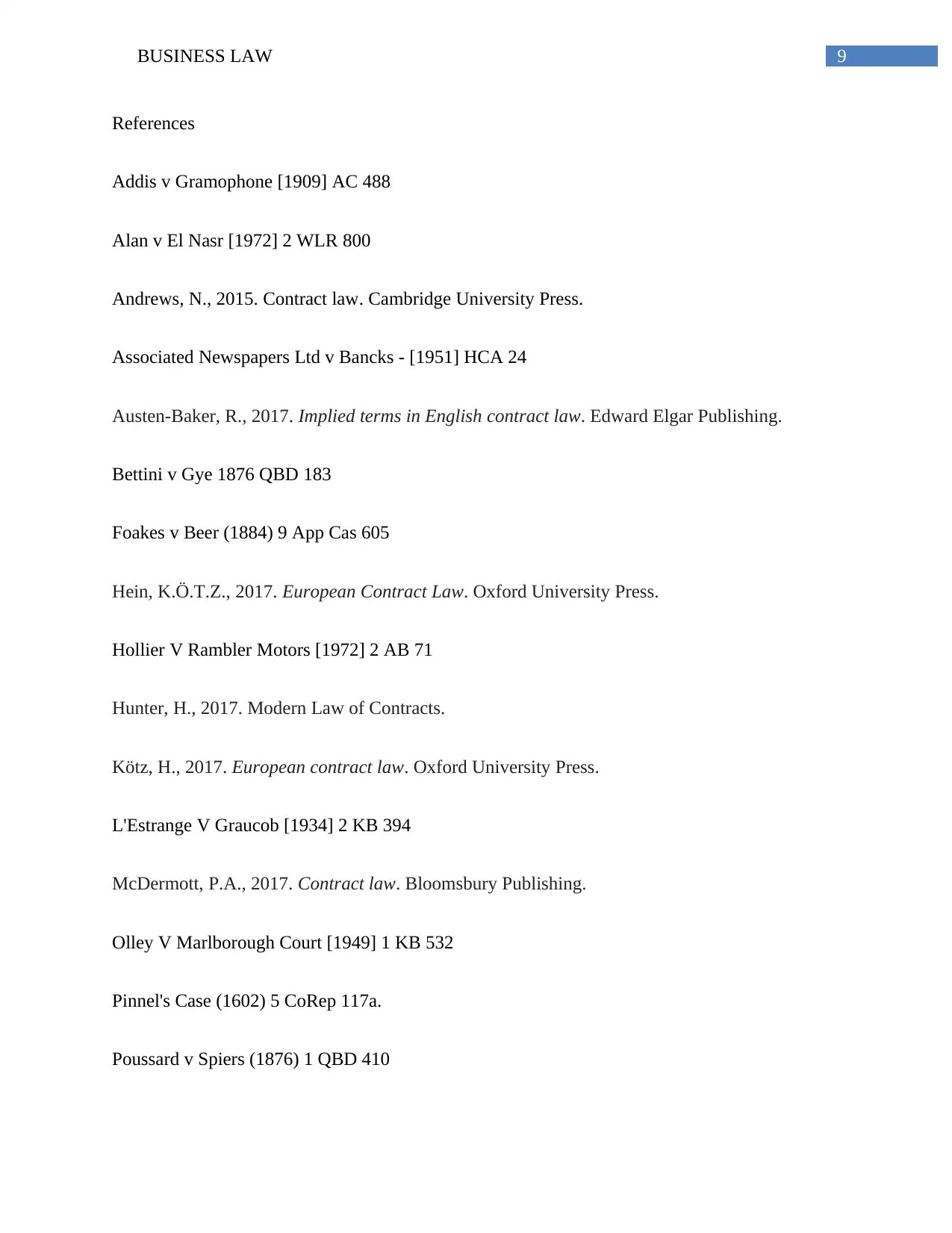
9BUSINESS LAW
References
Addis v Gramophone [1909] AC 488
Alan v El Nasr [1972] 2 WLR 800
Andrews, N., 2015. Contract law. Cambridge University Press.
Associated Newspapers Ltd v Bancks - [1951] HCA 24
Austen-Baker, R., 2017. Implied terms in English contract law. Edward Elgar Publishing.
Bettini v Gye 1876 QBD 183
Foakes v Beer (1884) 9 App Cas 605
Hein, K.Ö.T.Z., 2017. European Contract Law. Oxford University Press.
Hollier V Rambler Motors [1972] 2 AB 71
Hunter, H., 2017. Modern Law of Contracts.
Kötz, H., 2017. European contract law. Oxford University Press.
L'Estrange V Graucob [1934] 2 KB 394
McDermott, P.A., 2017. Contract law. Bloomsbury Publishing.
Olley V Marlborough Court [1949] 1 KB 532
Pinnel's Case (1602) 5 CoRep 117a.
Poussard v Spiers (1876) 1 QBD 410
References
Addis v Gramophone [1909] AC 488
Alan v El Nasr [1972] 2 WLR 800
Andrews, N., 2015. Contract law. Cambridge University Press.
Associated Newspapers Ltd v Bancks - [1951] HCA 24
Austen-Baker, R., 2017. Implied terms in English contract law. Edward Elgar Publishing.
Bettini v Gye 1876 QBD 183
Foakes v Beer (1884) 9 App Cas 605
Hein, K.Ö.T.Z., 2017. European Contract Law. Oxford University Press.
Hollier V Rambler Motors [1972] 2 AB 71
Hunter, H., 2017. Modern Law of Contracts.
Kötz, H., 2017. European contract law. Oxford University Press.
L'Estrange V Graucob [1934] 2 KB 394
McDermott, P.A., 2017. Contract law. Bloomsbury Publishing.
Olley V Marlborough Court [1949] 1 KB 532
Pinnel's Case (1602) 5 CoRep 117a.
Poussard v Spiers (1876) 1 QBD 410
Paraphrase This Document
Need a fresh take? Get an instant paraphrase of this document with our AI Paraphraser

10BUSINESS LAW
Thornton V Shoe Lane Parking [1971] 1 All ER 686
Thornton V Shoe Lane Parking [1971] 1 All ER 686
1 out of 11
Related Documents
Your All-in-One AI-Powered Toolkit for Academic Success.
+13062052269
info@desklib.com
Available 24*7 on WhatsApp / Email
![[object Object]](/_next/static/media/star-bottom.7253800d.svg)
Unlock your academic potential
Copyright © 2020–2025 A2Z Services. All Rights Reserved. Developed and managed by ZUCOL.





